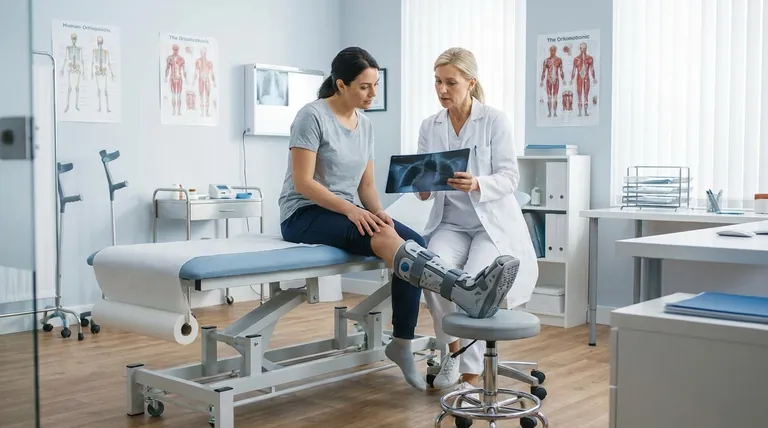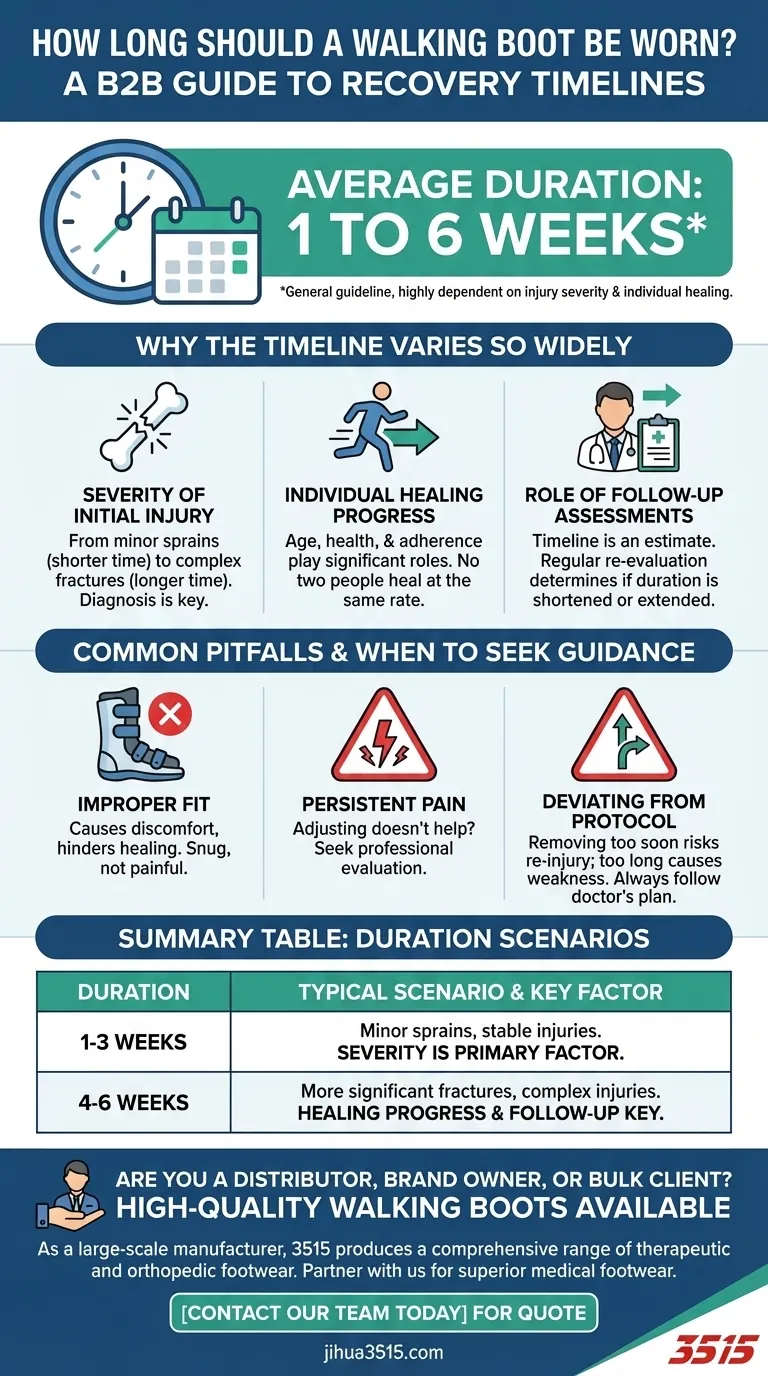On average, a doctor will recommend wearing a walking boot for a period of one to six weeks. This duration is not a fixed rule but a general guideline that is highly dependent on the seriousness of your injury and your body's unique healing process.
The 1-to-6-week timeframe is simply a starting point. The truly important factor is your specific diagnosis and the personalized recovery plan determined by your healthcare provider through ongoing assessment.

Why the Timeline Varies So Widely
The prescribed duration for wearing a walking boot is tailored to the individual. Several key factors influence your doctor's recommendation.
The Severity of the Initial Injury
A walking boot is used for a range of issues, from minor sprains to more significant fractures. A simple, stable injury will naturally require less time for healing than a complex one.
Your doctor's initial diagnosis is the primary factor in setting the expected timeline.
Your Individual Healing Progress
No two people heal at the same rate. Factors like age, overall health, and adherence to your treatment plan all play a significant role.
Your provider will monitor how your injury is responding at follow-up appointments to gauge your progress.
The Role of Follow-Up Assessments
The initial timeline is an estimate. Your doctor will likely re-evaluate your injury at regular intervals.
Based on these assessments, they may shorten or extend the time you need to wear the boot to ensure an optimal recovery.
Common Pitfalls and When to Seek Guidance
While a walking boot is a powerful tool for healing, its effectiveness depends on proper use and monitoring. It's crucial to stay in communication with your healthcare provider.
The Importance of a Proper Fit
An ill-fitting boot can cause discomfort or even hinder healing. The fit should be snug but not painfully tight.
If you cannot get the boot to fit correctly, it's essential to contact your doctor's office.
Responding to Pain or Discomfort
You should not experience persistent pain while wearing the boot. If discomfort continues even after adjusting the device, it's a sign that you need a professional evaluation.
Following Your Doctor's Protocol
The single biggest mistake is deviating from the prescribed plan. Attempting to remove the boot too soon can re-injure the area, while wearing it for too long without guidance can lead to other issues like muscle weakness.
Always seek guidance from a healthcare professional or orthopedic specialist to ensure you are using the boot correctly.
How to Apply This to Your Recovery
Your primary goal is to facilitate a complete and safe healing process. Use these principles to frame your approach.
- If you have a minor injury: You will likely be on the shorter end of the 1-to-6-week spectrum, but do not stop wearing the boot until cleared by your doctor.
- If you have a more severe injury: Be prepared for a longer duration and understand that follow-up appointments are critical for adjusting your recovery plan.
- If you have any questions or concerns at all: Contact your doctor immediately to ensure your condition is being managed correctly.
Ultimately, your recovery timeline is a dynamic process best managed in partnership with your healthcare provider.
Summary Table:
| Duration | Typical Scenario | Key Factor |
|---|---|---|
| 1-3 Weeks | Minor sprains, stable injuries | Severity of the initial injury |
| 4-6 Weeks | More significant fractures, complex injuries | Individual healing progress & follow-up assessments |
Are you a distributor, brand owner, or bulk client in need of high-quality walking boots?
As a large-scale manufacturer, 3515 produces a comprehensive range of therapeutic and orthopedic footwear. Our production capabilities ensure you receive durable, comfortable, and clinically appropriate walking boots to support your customers' recovery journeys.
Partner with us to supply superior medical footwear. Contact our team today to discuss your needs and get a quote.
Visual Guide

Related Products
- Safety Footwear Wholesale Manufacturer for Custom OEM/ODM Production
- Premium Wholesale Wheat Nubuck Safety Boot with Rapid Lacing System
- Premium Grain Leather Safety Boots for Bulk Supply
- Customizable Anti-Smash Safety Boots for Wholesale & Private Label Manufacturing
- Custom Wholesale Leather Safety Boots Direct Factory Manufacturing
People Also Ask
- Is it normal to wear shoes in the house? A Guide to Hygiene, Comfort & Culture
- What cultural and environmental considerations are tied to wearing shoes indoors? Balance Hygiene, Tradition, and Foot Health
- Do snake bite boots work? Your Ultimate Guide to Effective Snake Bite Protection
- How do safety shoes contribute to cost savings for companies? A Strategic Investment in Risk and Cost Management
- What are OSHA approved shoes? Understanding the Correct Standards for Workplace Safety



















